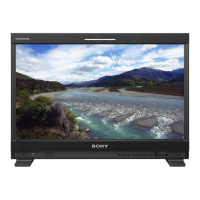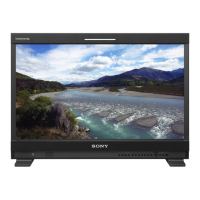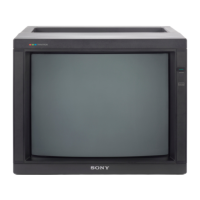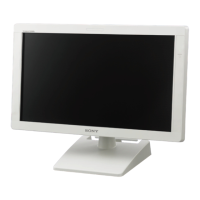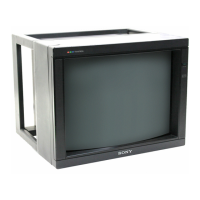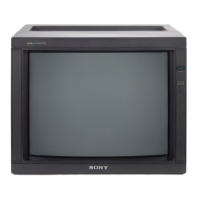
Do you have a question about the Sony PVM-2541A and is the answer not in the manual?
| Output Connectors | BNC |
|---|---|
| Input Connectors | BNC |
| Viewing Angle | 160 degrees |
| Power Requirements | 100-240V AC, 50/60Hz |
| Screen Size | 25 inches |
| Display Device | Trinitron CRT |
| Color Depth | 10-bit |
Section for recording model and serial numbers for reference.
Essential safety guidelines for operating and handling the apparatus safely, including electrical and installation warnings.
Precautions against water exposure, liquid spills, hearing damage, and rack installation hazards.
Information on compliance with FCC, IC, and European EMC directives.
Guidelines for safe operation, power source, and handling potential hazards.
Recommendations for installation and handling the screen to prevent damage.
Information on OLED burn-in, screen saver, and screen maintenance.
Guidance on dew condensation, repacking, unit disposal, and fan error troubleshooting.
Explanation of TRIMASTER technology and advantages of OLED panel technology.
Highlights advanced features like external remote control, signal analysis, and camera focus assist.
Details video processing features like I/P mode, color space, gamma, and markers.
Features related to control, illumination, screen saver, mounting, and stand compatibility.
Details the function and location of front panel buttons, indicators, and connectors.
Explains the operation of the menu system, return function, and standby switch.
Lists adjustable items for Composite, SDI, and HDMI/DVI input signals.
Details SDI, Composite, and Audio connectors on the PVM-2541A rear panel.
Details SDI, Composite, and Audio connectors on the PVM-1741A rear panel.
Explains the function of remote, HDMI, and DC IN connectors on the rear panel.
Provides steps for removing the pre-attached monitor stand from both models.
Instructions for mounting the PVM-1741A unit into a standard rack.
Provides step-by-step instructions for adjusting monitor height using the SU-561 stand.
Detailed steps for connecting the AC power cord to the unit.
Guides the user through selecting the correct geographical area for default settings.
Details the process of selecting the desired language for the on-screen menu.
Describes how to access and navigate the monitor's on-screen menu system.
Explains how to modify settings, adjust values, and confirm changes within the menu.
Lists items displayed in the monitor's STATUS menu for current settings.
Details adjustments for color temperature and color space settings.
Lists picture adjustment and system configuration options available in menus.
Provides details on what the STATUS menu displays for video and DVI input.
Explains how to adjust color temperature and color space settings using measurement instruments.
Describes how to select color spaces like EBU, SMPTE-C, ITU-709, or OFF.
Explains settings within SUB CONTROL, AUTO CHROMA/PHASE, and PICTURE CONTROL submenus.
Details SHIFT H and SHIFT V adjustments for picture position.
Covers FORMAT DISPLAY, LANGUAGE, and GAMMA settings within USER CONFIG.
Describes I/P mode for interlace signals and LED brightness adjustment.
Covers DVI format, screen saver activation, and flicker reduction settings.
Details SD pixel mapping for composite input based on picture size.
Explains how to enable, select, and adjust display markers for broadcast use.
Details time code display settings including format and transparency.
Details settings for waveform monitor, audio level meter, and vectorscope displays.
Explains adjustments for position, color, intensity, zoom, line select, and target.
Explains focus modes, color selection, and adjustment parameters like frequency and gain.
Explains how to assign functions to buttons and describes their operations.
Explains how to adjust brightness, contrast, chroma, volume, phase, aperture, and focus.
Details time code display and flicker free settings for enhanced viewing.
Illustrates different scan modes (Normal, Over, Native) for various input signals.
Explains closed caption type selection and character luminance.
Details audio channel selection for SDI input and speaker output formats.
Explains how to assign functions to parallel remote connector pins.
Lists available functions that can be assigned to parallel remote pins.
Covers forced tally assignment and serial remote, monitor, controller, and connection settings.
Describes how to lock or unlock settings to prevent unauthorized changes.
Provides solutions for common operational problems like unit failure or display issues.
Lists detailed specifications for picture performance characteristics.
Details power requirements, consumption, and inrush current for the unit.
Lists recommended operating conditions and supplied accessories.
Lists compatible signal formats and parallel remote connector pin assignments.
Lists applicable DVI input signal resolutions and their timing parameters.
Shows the dimensions and mass of the PVM-2541A and its variant with the stand.
Shows the dimensions and mass of the PVM-1741A and its variant with the stand.
